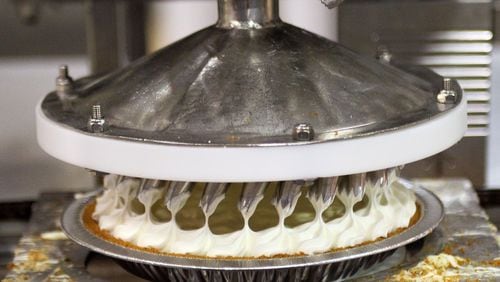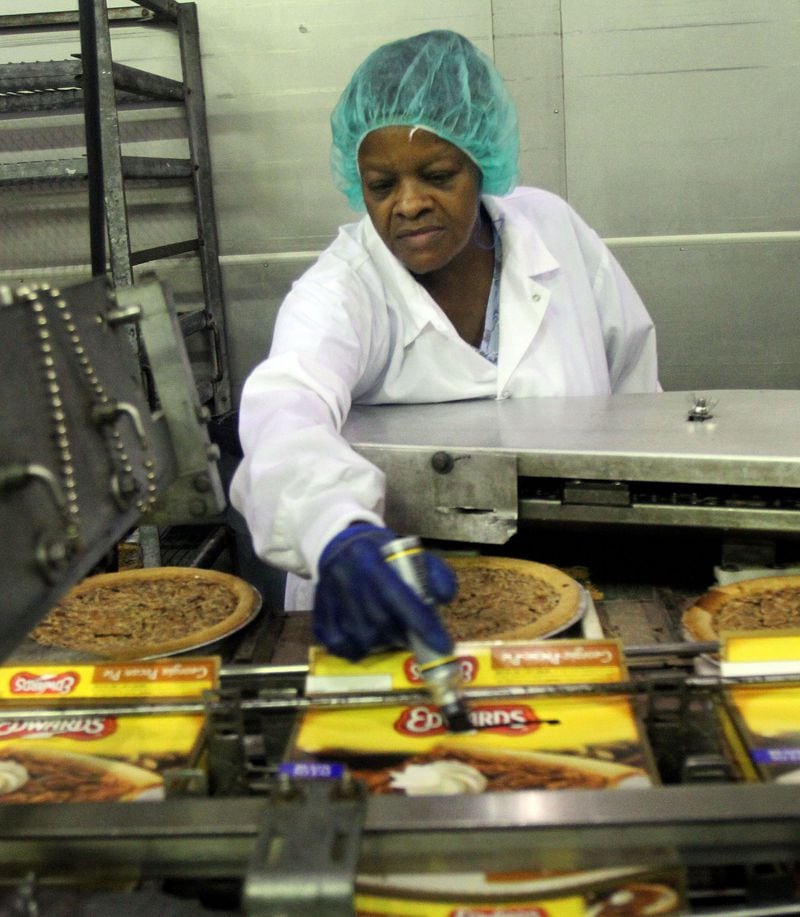This article by former AJC food critic John Kessler originally appeared in the October 2010 AJC.
If you have ever driven down DeKalb Avenue, skirting along the MARTA tracks, your mind a jumble of home and work, your eyes focused on the vagaries and changing direction of the middle lane, you have smelled the Smell.
Oh, that most excellent smell! That consciousness-piercing smell of buttery goodness filling the ether, of a thousand grandmas leaning over a thousand window ledges and holding out fresh-from-the-oven pie.
Pie!
Pie. Pie. Pie. Pie.
That aroma of freshly baked pie reaches out like a steam tendril. No, like a crooked index finger, beckoning you. And even as your eyes focus on the late-model Volvo one car length in front, you have an out-of-body experience, rising like a blissed-out cartoon character, floating through the air, to that pie on the ledge.
If you have smelled the Smell, you have asked the question and gotten the answer. There is a pie factory here, the bodacious Edwards pie factory that started as a retail bakeshop some 60 years ago and presently churns out pie after pie destined for the supermarket freezer.
Now part of the Minnesota-based Schwan Food Co., the plant produces both Edwards and Mrs. Smith's branded pies as well as any number of signature pie served in quick-service and family restaurants.
Credit: Phil Skinner
Credit: Phil Skinner
How much pie? So much pie. The plant runs from 5 a.m. until midnight, 27 days out of 28, and 140,000 pies leave it every day. There are dozens of flavors --- Key lime is a best-seller, Georgia pecan a source of local pride, Hershey's Chocolate Creme an indulgence to make "thaw and serve" sound like the best directive in the English language. All in all, 42 million pies a year leave this industrial enclave among the leafy streets of residential Atlanta.
The Edwards pie factory occupies a fenced-in plant in the Edgewood neighborhood, so close to the railroad tracks that twice trains have crashed through its windows. It is close enough to the Craftsman bungalows of Candler Park that residents get a blast of the factory's smell when they walk their dogs.
"I mostly notice it in the morning, " Frani Green says with a laugh, sitting on the patio of the San Francisco Coffee Roasting Co. on DeKalb Avenue. "It's this wafting aroma of sweetness that makes you really, really hungry." She thinks for a moment before adding, "But you know what? It's not the smell of pie as much as, I don't know, doughnuts. Or maybe a honey bun fresh out of the oven. Whatever it is, I feel like you can get a cavity from it."
Like many residents, Green knows the pie factory is "somewhere over there" but has little idea that it is, in fact, directly across the train tracks. Low-slung brick buildings and an abundance of trucks at the ready mark the spot.
Supply chain manager Jim Erdman meets me outside. He looks like a man who enjoys his pie, and is the first of many longtime Edwards employees who mention their body weight from the year they started. Another is F.H. Garcia --- a dough tempering expert who calibrates the recipe to account for variations in temperature and protein content in the flour. He has been with the company for 34 years and knew founder Tom Edwards, who initially opened the bakeshop around the corner on Mayson Avenue. It has been in its present location since 1970.
As Erdman leads me through the plant, he rattles off hilarious terms ("caramel injection") and factoids ("the largest sweetened condensed milk user in the world"). A man driving a forklift honks, waves and scuttles by with a payload of chocolate cream pies, their nondairy whipped topping rosettes as cheerful as a kindergartner's finger painting. It all seems a little like Willy Wonka, and a little like Lucy and Ethel's chocolate factory.
Three pie lines are operating concurrently. The Key lime pie --- an award-winning recipe that is the cornerstone of the Edwards line --- sails by on one conveyor belt while apple crumb pie (made with fresh Washington state apples that arrive peeled and sliced) head in the opposite direction.
Georgia pecan pie production occupies a third line. Made exclusively with South Georgia pecans, it is the best-selling baked pie in the Edwards line, selling to the tune of 2.4 million pies a year. Each pie contains precisely 106 grams of pecan halves and pieces that smell of fresh nut oils, unlike the sometimes rancid packages sold in grocery stores.
The crust --- mixed, rolled between floured rollers, cut and stamped onto aluminum plates --- isn't behaving properly. One after another, the crusts don't land squarely on the tins.
"We sometimes have some problems with it not sheeting properly, " Erdman admits, since the company stopped using trans fats in its dough recipe two years ago. In the beginning the dough would "crumble rather than flake, " but for the most part the company is now happy with its new formula. All its products are 100 percent trans-fat free.
The pecan pies will go from the 100-foot-long oven, to the freezer (inside which lurks a spiraling tower of conveyance) to the boxing line. Any pies with funky crusts will be marked as seconds. Just before going into the box, they pass through an X-ray to look for foreign objects such as nuts and bolts from the machinery that may have stowed away in the filling, as well as bits of plastic that occasionally travel with the pecans. Routine testers run through the machinery to make sure it functions properly.
Before we leave the manufacturing floor (to go to a conference room and feast on pie, I might add) we visit the cookie area. In order to make the crumbs for the Key lime and other pies, one oven does nothing but churn out hundreds of thousands of cookies. Domino-shaped tiles punched with holes emerge from a dough-mixing machine, then enter a long oven that radiates intense heat. The cookies appear on the other side as golden brown crisps and finally climb a steeply pitched conveyance to a machine that will pulverize them into dust.
The oven itself occupies an alcove on the northern edge of the plant. Only floor-to-ceiling plate windows separate it from the train tracks a few feet away.
I stand by this oven and breathe deeply, breathe in the pure joy coming from this inferno and think to myself, "I recognize this smell."







